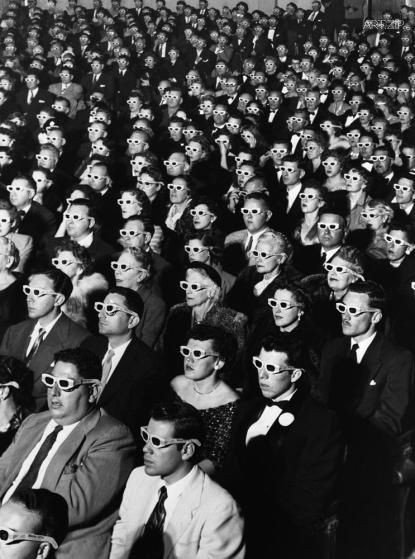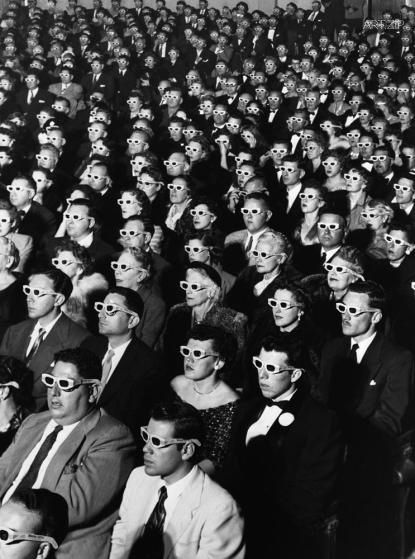

Fig.1 J.R. Eyerman – Bwana Devil, 1952, Photograph (http://time.com/3878055/3-d-movies-revisiting-a-classic-life-photo-of-a-rapt-film-audience/)
For the full version go to Re-Sounding Blog A space for thinking about sound and audiovision.
When viewing a film in a cinematic environment the individual spectator is absorbed into the audience. They are drawn into the 2D illusion and into empathizing with the characters, their eyes are dictated to by the camera. This is a face-value interpretation of cinema, and is one that reduces the experience to a simple subject-object dichotomy. This dualism, whether correct or not, situates neither film nor audience in a positive light: the object, in this case the film, dictatorially absorbs the viewer in an illusionistic world, whilst the role of the subject is occupied by the audience, who passively submits to the filmic journey. This understanding of film is a simplification, according the film theorist Vivian Sobchack who posits an interpretation of cinematic experience that is based on communication. In her book ‘The Address of the Eye: A Phenomenology of Film Experience’ Sobchack states that there are two entities which exist as both subject and object:
The direct engagement, then, between spectator and film in the film experience cannot be considered a monologic one between a viewing subject and a viewed object. Rather, it is a dialogical and dialectical engagement of two viewing subjects who also exist as visible objects. (V.S, 23, 1992)
The interpretations and criticisms of cinema can be linked to the texts of Martin Heidegger. The film as object and audience as subject relationship is one that he positioned himself against. Therefore, Heidegger negatively viewed representationalism and aesthetics due to the fact that they perpetuate a subject-object mode of thinking. Hubert L. Dreyfus and Barbara Bolt both discuss this. In ‘Art Beyond Representation: The Performative Power of the Image, Barbara Bolt analyses Heidegger’s thoughts relating to representationalism. In Dreyfus’ book ‘Being-in-the-World: A Commentary on Heidegger’s Being and Time, Division 1’, he states that: Heidegger questions the view that experience is always and most basically a relation between a self-contained subject with mental content (the inner) and an independent object (the outer).” (H.L.D, 5, 1991) The cinematic audience can also be viewed within Heideggerian thought through the Dasein and Das Man.
By applying these concepts to the cinema, the relationship between the film and viewer will be analysed in order to explore whether the audience truly is a passive entity, and whether this could ever be broken without disintegrating the cinematic experience. For this text, the analysis of the filmic encounter will be limited purely to those that take place within a cinema auditorium. Therefore, any other showcase of film, including those projected onto the white wall of a gallery, will be excluded. These encounters are each different to the one experienced in a cinema, and thus must be considered separately. Within this text, when speaking of cinema, one refers to the apparatus of commercial cinema, what Erika Balsom, in ‘Exhibiting Cinema in Contemporary Art’, refers to when she uses Michel Foucault’s term the dispositif[1]: “In the case of cinema, the classical dispositif would thus include everything from the celluloid print to the projector, the theater, ticketing policies, audience protocol, distribution practices, advertising methods, and more.” (E.B, 16, 2013)
In order to examine the communications between film and viewer the notion of a standard ‘Hollywood’ film will be contrasted with two examples, the art work of Janet Cardiff and Georges Bures Miller and the films of Robert Bresson, that can be seen to attempt to break the illusionistic hold that film has with the viewer.
The simplified understanding of the filmic experience, which Sobchack theorizes against, places the viewer within the passive entity of the audience. This can be aligned with Heidegger’s concept of Dasein and Das Man. In ‘Being and Time’, Heidegger sets out his thoughts surrounding the human being, or the Dasein. Heidegger’s concept of human existence is a being-in-the-world; it is not an idea of life within solitary confinement. Instead the being is tied to a full world, it is an essential part of existence: “But to Dasein, Being in a world is something that belongs essentially. Thus Dasein’s understanding of Being pertains with equal primordiality both to an understanding of something like a ‘world’, and to the understanding of the being of those entities which become accessible within the world.” (M.H, 13, 2008) However because Dasein is a public being it potentially becomes an inauthentic entity, which Heidegger referred to as Das Man, which is often translated as the ‘they’ or ‘one’[2]. The Dasein falls away from itself and into the Das Man, which is a public mass of beings, as Heidegger explains:
In utilizing public means of transport and in making use of the information services such as the newspaper, every Other is like the next. This Being-with-one-another dissolves one’s own Dasein completely into the kind of Being of ‘the Others’, in such a way, indeed, that the Others, as distinguishable and explicit, vanish more and more. In this inconspicuousness and unascertainability, the real dictatorship of the ‘they’ is unfolded. (M.H, 164, 2008)
The fallen Dasein is an inescapable possibility, due to the fact that the Dasein is a being-in-the-world. When applied to the apparatus of cinema, the Das Man becomes the audience, a public entity, which the spectator has fallen into. The passive cinematic Das Man lets the film wash over them, as Geoff King describes: “Sitting back and simply ‘taking-in’ the spectacle, the impact of the ‘big’ special effects, seeing to be as important a source of pleasure in these films as the joys of narrative; perhaps more so, or at least more obviously so for many viewers.” (G.K, 29, 2000). In ‘Spectacular Narrative: Hollywood in the Age of the Blockbuster’, King discusses the typical large-scale, big budget, Hollywood film, citing ‘Independence Day’, ‘Titanic’ and ‘Star Wars’ as examples. This form of film can be contrasted with those that draw attention to the medium and make the viewer medium-aware. In ‘Projecting Illusion: Film Spectatorship and the Impression of Reality’ Richard Allen, like Sobchack, argues that the subject-object duality is illogical. Instead Allen, using the theories of French critic Jean-Pierre Oudart, states the viewer actively takes part in the illusionistic realm of cinema. Allen applies Richard Wollheim’s theory of ‘seeing-in’, which Wollheim sets out in ‘Painting as an Art’. Within the realm of painting, the spectator sees a painting, the painterly marks, and how it forms the pictorial illusion: “On the other hand, the medium-aware viewer of a representational painting – the viewer who looks at a painting as a painting of something – looks at the way in which the surface of the painting has been marked in order to produce an image of the object.” (R.A, 83, 1995)
By applying this to cinema, Allen suggests the medium-aware spectator. This is a viewer who is aware that they are seeing a ‘projected illusion’; they entertain the idea that what they are seeing is real, but know it is not. When discussing medium-awareness, Allen states that it is not predictable and not stable. Allen also discusses the nature of perceptual oscillation, where the viewer is unable to see both the brushstrokes within the paint and the depicted object at the same time. If this is applied to film, two states can exist within cinema for the spectator, the first is the zone of medium-awareness where the viewer is awake to their surroundings within the cinematic apparatus, the second is where the spectator is subsumed within the audience and immersed into the illusionary spectacle of cinema. Within the second space, the viewer has lost their sense of self: the Dasein is absorbed into the cinema and into the Das Man.
[1] Balsom states that Michel Foucault uses and defines dispositif, in ‘Confessions of the Flesh’ in ‘Power/Knowledge’.
[2] ‘One’ is the translation that Hubert L. Dreyfus uses for Das Man in ‘-in-the-World: A Commentary on Heidegger’s Being and Time, Division 1’. ‘They’ is used in the English translated version of ‘Being and Time’ by Heidegger.
For the full version go to Re-Sounding Blog A space for thinking about sound and audiovision.

